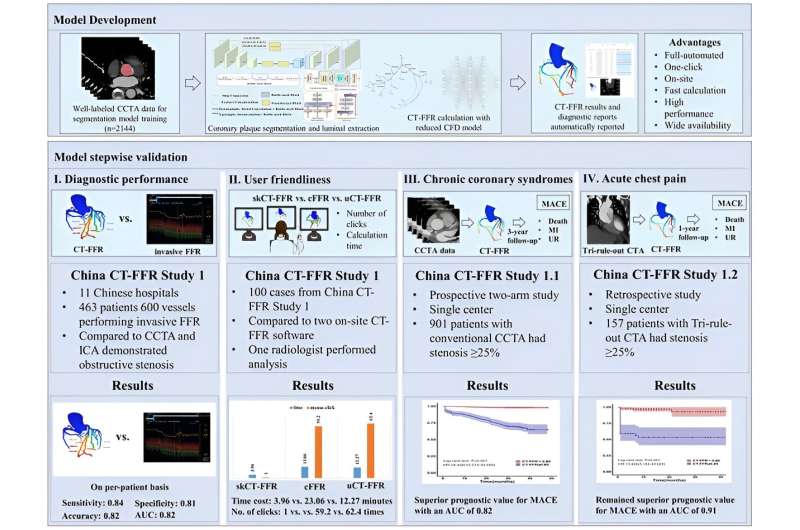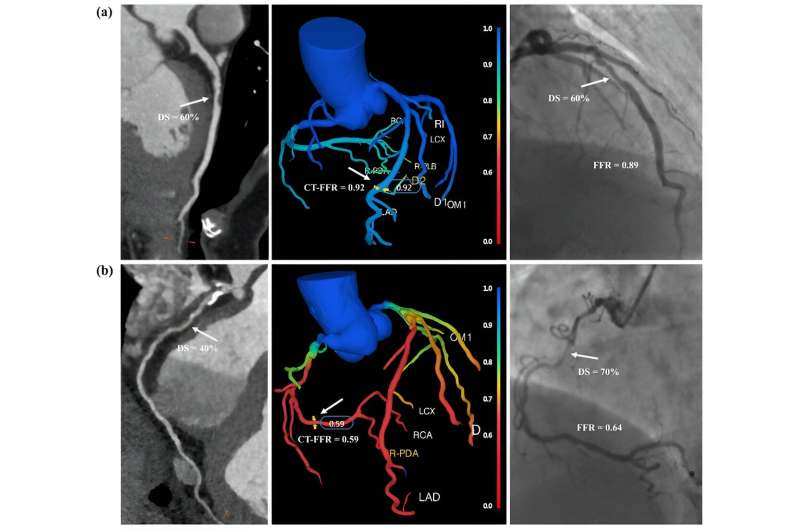
In a 3-stage study, three cohorts were used for diagnostic performance, and prognostic performance evaluation for this fully automated, one-click, on-site CT-FFR technique. The study was led by Professors Long Jiang Zhang and Guang Ming Lu (Department of Radiology, Jinling Hospital, Affiliated Hospital of Medical School, Nanjing University). The work is published in the journal Science Bulletin.
In cohort 1, a total of 463 patients and 600 coronary vessels with CCTA images and following invasive fractional flow reserve (FFR) results were collected for diagnostic performance and user-friendliness evaluation. CT-FFR had a strong correlation with invasive FFR both on a per-vessel basis and per-patient basis (Pearson R = 0.68, 95% CI: 0.63–0.72 and Pearson R = 0.70, 95% CI: 0.65–0.75, P <0.0001, respectively).
CT-FFR had a sensitivity of 0.84, specificity of 0.81, and accuracy of 0.82 for identifying functional myocardial ischemia on a per-patient basis. On a per-vessel basis, sensitivity, specificity, and accuracy of CT-FFR were 0.80, 0.83, and 0.82, respectively.
Furthermore, the authors have compared the user-friendliness between this fully-automatic on-site CT-FFR with other two manual-dependent on-site CT-FFR software (Siemens, cFFR and United-Imaging, uCT-FFR), and found it was associated with significantly reduced calculation time (less than 4 minutes) and number of mouse clicks (only one-click) of CT-FFR analysis.
In cohorts 2 and 3, a total of 901 participants with chronic coronary syndromes and 157 participants with acute chest pain were collected, respectively. Worse outcomes were associated with positive CT-FFR results (CT-FFR ? 0.80) than negative CT-FFR results (CT-FFR > 0.80) both in participants with chronic coronary syndromes and ones with acute chest pain.
This is the first reported fully-automatic CT-FFR technique, and demonstrated similar diagnostic performance compared to HeartFlow and Siemens CT-FFR technique.

More information:
Bangjun Guo et al, Diagnostic and prognostic performance of artificial intelligence-based fully-automated on-site CT-FFR in patients with CAD, Science Bulletin (2024). DOI: 10.1016/j.scib.2024.03.053
Citation:
Fully-automated one-click on-site CT-FFR: A tool for evaluating patients with coronary artery disease (2024, April 26)
fully-automated-click-site-ct.html
.
. The content is provided for information purposes only.
